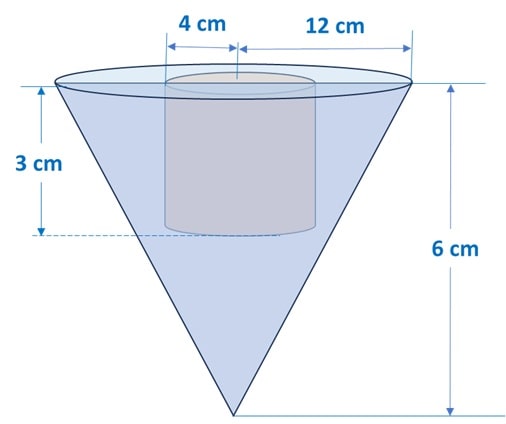Q) From a solid right circular cone, whose height is 6 cm and radius of base is 12 cm, a right circular cylindrical cavity of height 3 cm and radius 4 cm is hollowed out such that bases of cone and cylinder form concentric circles. Find the surface area of the remaining solid in terms of π.
Q34 A – Sample Question Paper – Set 1 – Maths Standard – CBSE 2026
Ans:
Note: Concentric means circles have same centre. Hence, we will take radius of the cone and cylinder around around same axis.
Let’s start by making a neat diagram for better understanding of the question:

When a cylinder is cut from the cone’s base, the Curved surface area of remaining solid will be cumulative of following surface areas:
a) Curved surface area of the Cone
b) Base Area which will be net of Cone’s base area – Cylinder’s base area
c) Total surface area of Cylinder which will be sum of curved area of Cylinder + Cylinder’s base area (only 1 base is included, other base gets removed while hollowing out the solid)
Let’s calculate each of them one by one:
a) Curved surface area of the Cone:
Given that Radius of Cone, Rcone = 12 cm and Height of Cone, Hcone = 6 cm
∴ Slant height of the Cone, Lcone = √ [(12)2 + (6)2] = √ (144 + 36) = √ 180 = 6√5 cm
Curved surface area of the Cone = π Rcone Lcone = π x 12 x 6 √ 5 = 72 √5 π cm2
b) Base Area:
Base area = Cone’s base area – Cylinder’s base area
= π Rcone2 – π Rcyl2
= π x 122 – π x 42
= 144 π – 16 π = 128 π cm2
c) Total surface area of Cylinder = Curved area of Cylinder + Cylinder’s base area
= 2 π Rcyl Hcyl + π Rcyl2
= 2 π x 4 x 3 + π (4)2
= 24 π + 16 π = 40 π cm2
d) ∵ Curved surface area of remaining solid = Curved surface area of the Cone + Base Area + Total surface area of Cylinder
= 72 √5 π + 128 π + 40 π = 168 π + 72 √5 π = (168 + 72 √5 ) π cm2
Therefore, the Surface area of the remaining solid is (168 + 72 √5 ) π cm2
Please do press “Heart” button if you liked the solution
